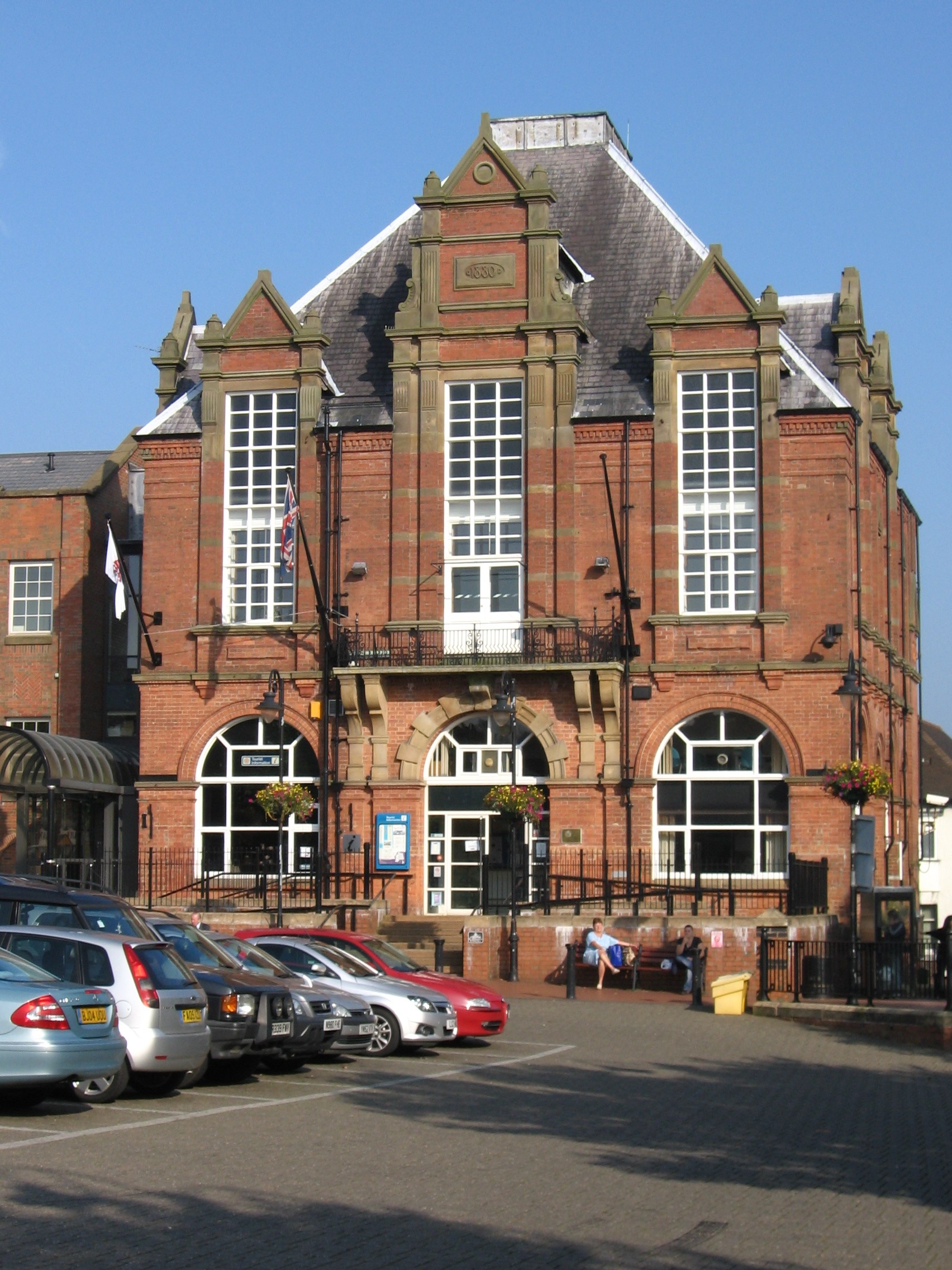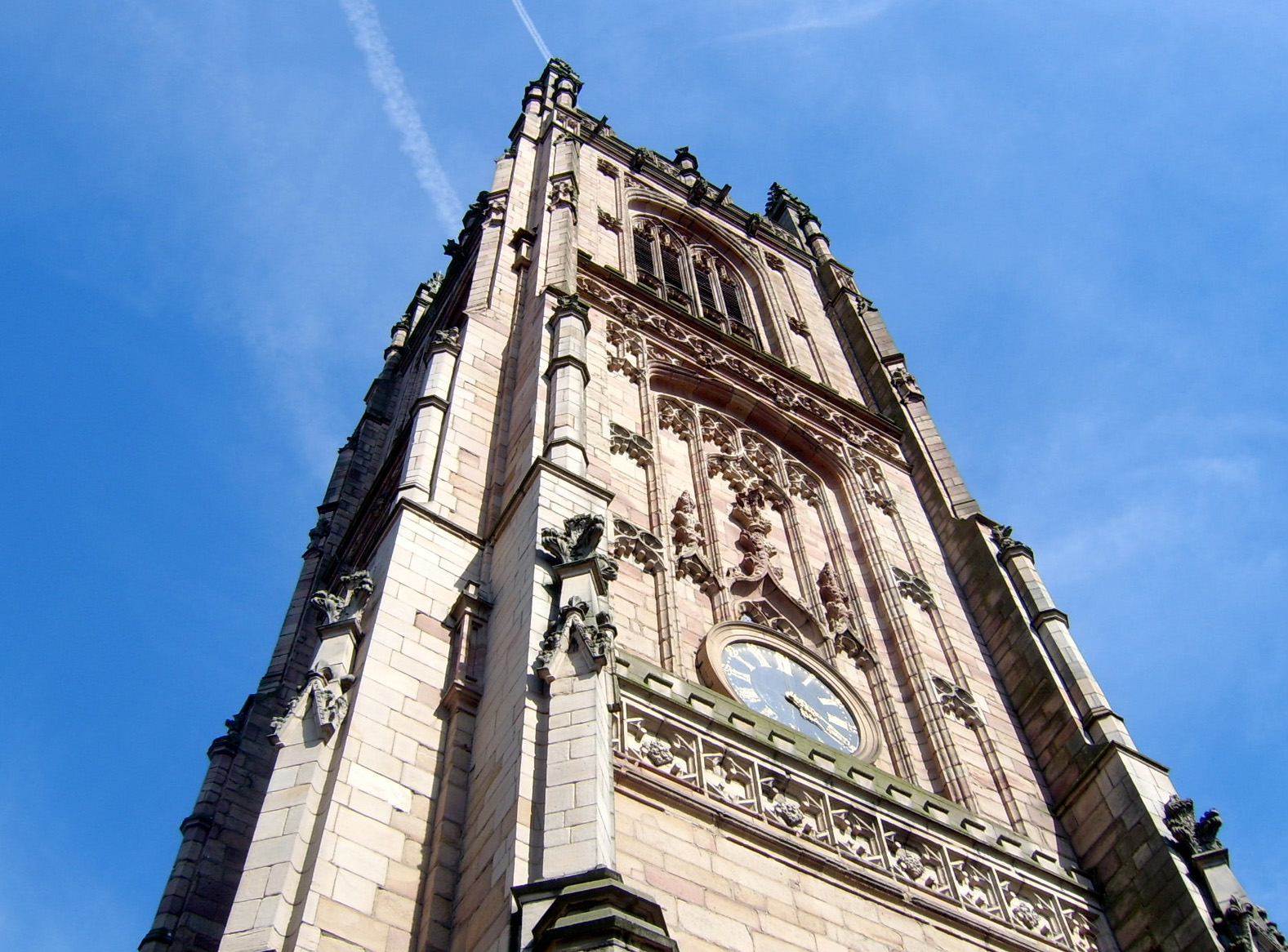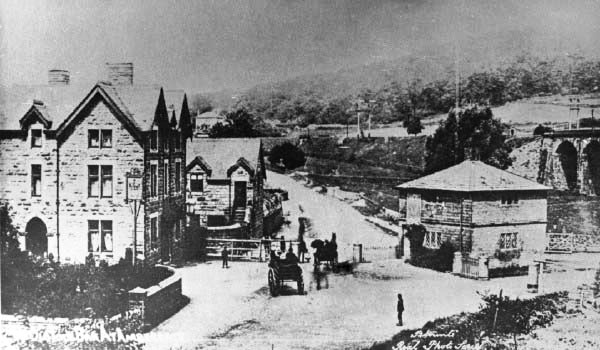|
Ripley, Derbyshire
Ripley is a market town and civil parish in the Amber Valley district of Derbyshire, England. It is northeast of Derby, northwest of Heanor, southwest of Alfreton and northeast of Belper. The town is continuous with Heanor, Eastwood, Nottinghamshire, Eastwood and Ilkeston as part of the wider Nottingham Urban Area. History Little information remains as to when Ripley was founded, but it appears in the 1086 Domesday Book, when it was held by a man called Levenot. In 1251 Henry III granted a charter for "one market one day a week, on Wednesday, at [the] manor of Ryppeleg: and one fair each year lasting three days, on the Vigil Day and Morrow of St Helen". Ripley Fair antedates Nottingham Goose Fair. The market day was later altered to Saturdays, with an extra market on Fridays. Medieval Ripley was just a few stone cottages and farms around a village green, with a few dwellings further afield. Corn was ground at a mill owned by the Abbot of Darley Abbey, Darley. In 1291, Ripley had ... [...More Info...] [...Related Items...] OR: [Wikipedia] [Google] [Baidu] [Amazon] |
Town
A town is a type of a human settlement, generally larger than a village but smaller than a city. The criteria for distinguishing a town vary globally, often depending on factors such as population size, economic character, administrative status, or historical significance. In some regions, towns are formally defined by legal charters or government designations, while in others, the term is used informally. Towns typically feature centralized services, infrastructure, and governance, such as municipal authorities, and serve as hubs for commerce, education, and cultural activities within their regions. The concept of a town varies culturally and legally. For example, in the United Kingdom, a town may historically derive its status from a market town designation or City status in the United Kingdom, royal charter, while in the United States, the term is often loosely applied to incorporated municipality, municipalities. In some countries, such as Australia and Canada, distinction ... [...More Info...] [...Related Items...] OR: [Wikipedia] [Google] [Baidu] [Amazon] |
Morley Park
Morley Park is an area within Heage, in the parish of Ripley in the English county of Derbyshire, north of Derby. It is about five miles north of the village of Morley itself. At the Norman Conquest it was within the wapentake of Morleyston. In the reign of Henry II it was within the newly created Forest of East Derbyshire. When the area was disafforested in 1225, it may have been taken over when William de Ferrers, 4th Earl of Derby extended Duffield Frith to include the manor of Bradley, now part of Belper. In 1266 the area became part of the Duchy of Lancaster. It was an enclosed area, one of the seven royal parks within the Frith. Adjacent to it was the smaller ''Belper'' or ''Lady'' Park. In the nineteenth century Morley Park was the site of iron smelting furnaces, some of which have been preserved and can be seen from the A38 road The A38, parts of which are known as Devon Expressway, Bristol Road and Gloucester Road, Bristol, Gloucester Road, is a major A-class t ... [...More Info...] [...Related Items...] OR: [Wikipedia] [Google] [Baidu] [Amazon] |
Belper
Belper () is a town and civil parish in the local government district of Amber Valley in Derbyshire, England, located about north of Derby on the River Derwent. Along with Belper, the parish includes the village of Milford and the hamlets of Bargate, Blackbrook, and Makeney. As of the 2011 Census, the parish had a population of 21,823. Originally a centre for the nail-making industry since the Middle Ages, Belper expanded during the early Industrial Revolution to become one of the first mill towns with the establishment of several textile mills; as such, it forms part of the Derwent Valley Mills World Heritage Site. History At the time of the Norman occupation, Belper was part of the land centred on Duffield held by the family of Henry de Ferrers. The Domesday Book of 1086 records a manor of "Bradley" which is thought to have stood in an area of town now known as the Coppice. At that time it was probably within the Forest of East Derbyshire which covered the who ... [...More Info...] [...Related Items...] OR: [Wikipedia] [Google] [Baidu] [Amazon] |
Alfreton
Alfreton ( or locally ) is a town and civil parishes in England, civil parish in the Amber Valley district of Derbyshire, England. The town was formerly a Norman Manor and later an Urban District. The population of the Alfreton parish was 8,799 at the 2021 Census. The villages of Ironville, Riddings, Somercotes and Swanwick, Derbyshire, Swanwick were historically part of the Manor and Urban District, and the population including these was 24,476 in 2001. History Alfreton is said to have been founded by King Alfred and to have derived its name from him. The placename appears in different forms throughout the ages, such as 'Elstretune' in Domesday, but the earliest record appears to occur in CE1004 in the will of Wulfric Spott, the founder of Burton Abbey. Amongst his bequests was 'Aelfredingtune', or 'Alfred's farmstead', which is believed to relate to Alfreton. However, there is no evidence that this Alfred was the aforementioned king. To the southwest near Pentrich was a Roma ... [...More Info...] [...Related Items...] OR: [Wikipedia] [Google] [Baidu] [Amazon] |
Heanor
Heanor (/ˈhiːnə/) is a town in the Amber Valley district of Derbyshire, England. It lies north-east of Derby and forms, with the adjacent village of Loscoe, the civil parishes in England, civil parish and town council-administered area of Heanor and Loscoe, which had a population of 17,251 in the United Kingdom Census 2011, 2011 census. History The name Heanor derives from the Old English ''hēan'' (the dative form of ''hēah'') and ''ofer'', and means "[place at] the high ridge". In the Domesday Book of 1086 it was recorded as ''Hainoure'', with its entry stating: 6M In CODNOR and Heanor and Langley [in Heanor] and 'Smithycote' [in Codnor Park] 8 thegns had 7 wikt:carucate, carucates of land to the wikt:geld, geld [before 1066]. [There is] land for as many ploughs. There are now 3 ploughs in demesne, and 11 villains and 2 bordars and 3 sokemen having 5½ ploughs. There is a church and 1 mill [rendering] 12d and of meadow [and] woodland pasture 2 League (unit), leagues long ... [...More Info...] [...Related Items...] OR: [Wikipedia] [Google] [Baidu] [Amazon] |
Derby
Derby ( ) is a City status in the United Kingdom, city and Unitary authorities of England, unitary authority area on the River Derwent, Derbyshire, River Derwent in Derbyshire, England. Derbyshire is named after Derby, which was its original county town. As a unitary authority, Derby is administratively independent from Derbyshire County Council. The population of Derby is (). The Romans established the town of Derventio Coritanorum, Derventio, which was later captured by the Anglo-Saxons and then by the Vikings who made one of the Five Boroughs of the Danelaw. Initially a market town, Derby grew rapidly in the industrial era and was home to Lombe's Mill, an early British factory and it contains the southern part of the Derwent Valley Mills World Heritage Site. With the arrival of the railways in the 19th century, Derby became a centre of the Rail transport in Great Britain, British rail industry. Despite having a Derby Cathedral, cathedral since 1927, Derby did not gain City ... [...More Info...] [...Related Items...] OR: [Wikipedia] [Google] [Baidu] [Amazon] |
Market Town
A market town is a settlement most common in Europe that obtained by custom or royal charter, in the Middle Ages, a market right, which allowed it to host a regular market; this distinguished it from a village or city. In Britain, small rural towns with a hinterland of villages are still commonly called market towns, as sometimes reflected in their names (e.g. Downham Market, Market Rasen, or Market Drayton). Modern markets are often in special halls, but this is a relatively recent development. Historically the markets were open-air, held in what is usually called (regardless of its actual shape) the market square or market place, sometimes centred on a market cross ( mercat cross in Scotland). They were and are typically open one or two days a week. In the modern era, the rise of permanent retail establishments reduced the need for periodic markets. History The primary purpose of a market town is the provision of goods and services to the surrounding locality. Al ... [...More Info...] [...Related Items...] OR: [Wikipedia] [Google] [Baidu] [Amazon] |
Cross Hill, Derbyshire
Cross Hill is a hamlet in Derbyshire Derbyshire ( ) is a ceremonial county in the East Midlands of England. It borders Greater Manchester, West Yorkshire, and South Yorkshire to the north, Nottinghamshire to the east, Leicestershire to the south-east, Staffordshire to the south a ..., England. It is located two miles south of Ripley. Technically speaking, it is actually within Codnor's limits. Hamlets in Derbyshire Geography of Amber Valley {{Derbyshire-geo-stub ... [...More Info...] [...Related Items...] OR: [Wikipedia] [Google] [Baidu] [Amazon] |
Codnor
Codnor is a village and civil parish in the Amber Valley district of Derbyshire, England. Codnor is a former mining village and had a population of 3,766 (including Cross Hill) taken at the 2011 Census. It is approximately 12 miles from Derby and 14 miles from Nottingham. Codnor forms a built up area with nearby Ripley. History Codnor is listed in an entry in the Domesday Book of 1086, the great survey commissioned by William the Conqueror; a mill and church were mentioned, and also the fact that "Warner holds it". Coalmining had a long history locally, and was, at one time, responsible for subsidence damage to some buildings. Opencast mining is still in operation today within the area and the land around the castle has also been subject to this. east of the village centre is Codnor Castle; the original Norman earthwork motte and bailey was built by William Peveril, (Peveril of the Peak, who also built the better known Peveril Castle at Castleton). The 13th-century sto ... [...More Info...] [...Related Items...] OR: [Wikipedia] [Google] [Baidu] [Amazon] |
Waingroves
Waingroves is a large village in the Amber Valley district of Derbyshire, England, approximately two miles away from the town of Ripley, Derbyshire, Ripley. It is in the civil parish of Codnor. In woodland to the south of the village, there are remains of a Coal Mining, colliery site. Waingroves Hall The land at "Waingrif" (Waingroves) was donated by Ralph fitzStephen to the Knights Hospitaller in the early 12th century. The "deed of gift" cites the date 1147, however another document reveals contact between the Abbot of Darley Abbey and the Knights Hospitaller, with regards to Waingroves, as early as 1121. The land was donated for the foundation of a preceptory of the Knights Hospitaller ''(a preceptory is a monastic establishment for one of a number of orders of monastic knights)'', however there is dispute as to whether one was ever constructed. Of those that believe a preceptory did exist, it is accepted that it only had a very short life: founded around 1147 and "supplanted ... [...More Info...] [...Related Items...] OR: [Wikipedia] [Google] [Baidu] [Amazon] |
Toadmoor
Ambergate () is a village in Derbyshire, England, situated where the River Amber joins the River Derwent. It is about south of Matlock. The village forms part of the Heage and Ambergate ward of Ripley Town Council with a population of 5,013 at the 2011 Census. Ambergate is within the Derwent Valley Mills UNESCO World Heritage site, and has historical connections with George Stephenson, and is notable for its railway heritage and telephone exchange. The village also hosts an annual carnival. The A610 road from Ripley and Nottingham joins the A6 trunk road at Ambergate as it runs north to south along the Derwent valley between Matlock and Derby. Neighbouring hamlets are Sawmills and Ridgeway. Alderwasley, Heage (the site of Heage Windmill), Nether Heage and Crich are other significant neighbouring settlements. Shining Cliff woods, Thacker's woods and Crich Chase border the village. History Name and origins Until the early 19th century it was known as Toadmoor, with no ... [...More Info...] [...Related Items...] OR: [Wikipedia] [Google] [Baidu] [Amazon] |
The Elms, Derbyshire
The Elms is a housing estate built by the town council in the 1950s to provide social housing on the south-western edge of Ripley, Derbyshire, England England is a Countries of the United Kingdom, country that is part of the United Kingdom. It is located on the island of Great Britain, of which it covers about 62%, and List of islands of England, more than 100 smaller adjacent islands. It .... It took its name from The Elms farm whose land it was built on. The house, called The Elms, was converted into flats and the farm yard and outbuildings were used as a depot by the council until demolition around the 1970s when sheltered housing was built on the site. The houses on the estate are traditionally built red brick, mainly three and four bedroom with the occasional five bedroom. Street names The streets are all named after trees. The estate comprises the following streets: * Almond Avenue * Ash Crescent * Chestnut Avenue * Cedar Avenue * Cherry Tree Avenue * Elms Avenue * ... [...More Info...] [...Related Items...] OR: [Wikipedia] [Google] [Baidu] [Amazon] |






